*NURSING > TEST BANK > Perspectives in Global Health Care Stanhope: Public Health Nursing: Population-Centered Health Care (All)
Perspectives in Global Health Care Stanhope: Public Health Nursing: Population-Centered Health Care in the Community, 10th Edition,100% CORRECT
Document Content and Description Below
Perspectives in Global Health Care Stanhope: Population-Centered Health Care in the Community, 10th Edition MULTIPLE CHOICE 1. What is the key to achieving the goals of Health for All in the 2... 1st Century (HFA21) worldwide? a. The cure of communicable disease b. The technological development of all nations c. The worldwide availability of health care insurance d. The worldwide implementation of primary health care ANS: D The major key to attaining Health for All by the Year 2000 was the worldwide implementation of primary health care; this has extended into the next century with the document HFA21. The World Health Assembly in 1977 stated that all citizens of the world should enjoy a level of health that would permit them to lead a socially and economically productive life. Curing communicable disease, technological developments of all nations, and availability of health care insurance are not part of the key strategies to achieve the goals of HFA21. DIF: Cognitive level: Understanding TOP: Nursing process: Planning MSC: NCLEX: Health Promotion and Maintenance 2. Which health problem is ofNgUreRatSesIt NcoGnTceBrn.iCn OthMe world’s developed countries? a. Hepatitis b. Malaria c. Polio d. Smallpox ANS: A Current health concerns in more developed countries are hepatitis, infectious diseases, and new viral strains such as hantavirus, SARS (severe acute respiratory syndrome), H1N1, and avian flu. Malaria, polio, and smallpox are more commonly found in lesser-developed countries. DIF: Cognitive level: Understanding TOP: Nursing process: Assessment MSC: NCLEX: Health Promotion and Maintenance 3. What disease that was once isolated and rare is now widespread throughout the world? a. Acquired immunodeficiency syndrome (AIDS) b. Smallpox c. Malaria d. Measles ANS: A Smallpox has been eradicated; malaria and measles were not isolated and rare throughout the world. AIDS was once isolated and rare but is now worldwide. DIF: Cognitive level: Understanding TOP: Nursing process: Assessment MSC: NCLEX: Health Promotion and Maintenance 4. Which country is referred to as being lesser-developed? a. France b. Japan c. Indonesia d. Sweden ANS: C A country that is not yet stable with respect to its economy and technological development is lesser-developed, which describes Indonesia. France, Japan, and Sweden are considered developed countries. DIF: Cognitive level: Remembering TOP: Nursing process: Assessment MSC: NCLEX: Safe and Effective Care Environment: Management of Care 5. The health priorities in HEALTH21 are based on what concept? a. Eradication of communicable disease worldwide b. Social justice and solidarity with an emphasis on the responsibility for health c. World trade and knowledge sharing about health concerns d. Provisions for the creation of the United Nations Children’s Fund (UNICEF) ANS: B HEALTH21 is not a single, finite goal but a strategic process that can lead to progressive improvement in the health of people. It is a call for social justice and solidarity with an emphasis on individual, famiUly, aSnd NcomTmunityOresponsibility for health. The concepts of eradication of communicable disease worldwide, world trade and knowledge sharing about health concerns, and provisions for the creation of UNICEF are not part of these health priorities. DIF: Cognitive level: Understanding TOP: Nursing process: Assessment MSC: NCLEX: Health Promotion and Maintenance 6. Population health is an approach and perspective that focuses on what? a. Controlling the spread of the HIV virus worldwide b. The broad range of factors and conditions that influence health c. Community-based care for all citizens d. Prevention and diagnosis of disease worldwide ANS: B Population health is a holistic approach that considers the total health system. The focus of population health is broader than only considering spread of the HIV virus. Population health considers more than the community-based care in the community. Population health examines spread of disease on a smaller scale. DIF: Cognitive level: Understanding TOP: Nursing process: Assessment MSC: NCLEX: Health Promotion and Maintenance 7. A nurse is examining the income levels and social networks of individuals in a community. Which term is used to identify the factors the nurse is investigating? a. Culture b. Development c. Community d. Determinants ANS: D Determinants are conditions and factors that are important considerations in population health. Culture refers to the beliefs and customs of a certain group. Development refers to something that is being created. Community is a group of people living in the same geographic location. DIF: Cognitive level: Remembering TOP: Nursing process: Assessment MSC: NCLEX: Safe and Effective Care Environment: Management of Care 8. What is a characteristic of multilateral organizations? a. Receiving their funding from multiple sources b. Controlling the spread of disease c. Feeding the people of the world d. Using nurses as their main source of information ANS: A Multilateral organizations are those that receive funding from multiple government and nongovernment sources. The other items are specific to the agencies listed, but do not include all the organizations. DIF: Cognitive level: ReNmUemRbSeIrinNgGTB.TCOOPM: Nursing process: Assessment MSC: NCLEX: Safe and Effective Care Environment: Management of Care 9. A nurse plans to contact a multilateral organization. Which organization would the nurse most likely contact? a. United Nations (UN) b. United States Agency for International Development (USAID) c. Project Hope d. Catholic Relief Services ANS: A A multilateral organization is one that receives funding from multiple governments and nongovernmental sources, which describes the UN. Project Hope and Catholic Relief Services are private voluntary organizations. USAID is funded by one country, the United States. DIF: Cognitive level: Understanding TOP: Nursing process: Planning MSC: NCLEX: Safe and Effective Care Environment: Management of Care 10. A nurse is caring for a client who has been diagnosed with tuberculosis (TB). Which medication would the nurse most likely administer? a. Isoniazid b. Nevirapine c. Amodiaquine d. Bacille Calmette-Guérin (BCG) ANS: A Isoniazid is one of several chemotherapeutic medications used to treat TB. Nevirapine is used to decrease the likelihood of maternal transmission of HIV-AIDS. Amodiaquine is one of several medications used to treat malaria. BCG is a vaccine that has been promoted as effective in inducing active immunity against TB. DIF: Cognitive level: Applying TOP: Nursing process: Implementation MSC: NCLEX: Physiological Integrity: Pharmacological and Parenteral Therapies 11. A nurse working in a lesser-developed country is caring for the women in the local community. Which existing factor regarding the women would be an important consideration for the nurse? a. They are at risk for a vitamin D deficiency. b. They are likely to have one child. c. They are at risk for death during pregnancy and childbirth. d. They are viewed as the leader of the family unit. ANS: C Most deaths to women worldwide are related to pregnancy and childbirth. Most of these deaths occur in lesser-developed countries. Common nutritional deficiencies in this population are zinc, iodine, vitamin A, folic acid, and calcium. One of the reasons this problem exists is because women are not seen as valued members of society. In developing nations there is a significant incidence of lack of prenatal care during pregnancy and high fertility rates, often due to a lack of access to contraception and other family planning and reproductive health services,Uas wSellNas cTulturalObelief systems that increase the lifetime risk of maternal death. DIF: Cognitive level: Understanding TOP: Nursing process: Planning MSC: NCLEX: Health Promotion and Maintenance 12. Which intergovernmental organization focuses its efforts on assisting countries in Latin America? a. Pan American Health Organization b. World Bank c. World Health Organization (WHO) d. United Nations Children’s Fund ANS: A The Pan American Health Organization serves as a regional field office in Latin America for the WHO. The World Bank’s major aim is to lend money to the lesser-developed countries so that they might use it to improve the health status of their people. The WHO addresses the wide scope and nature of the world’s health problems. The United Nations Children’s Fund is an advocate for the health needs of women and children under the age of 5. DIF: Cognitive level: Remembering TOP: Nursing process: Assessment 13. An example of a successful campaign against which of the following communicable diseases was carried out during the 1960s and 1970s? a. Tetanus b. Measles c. Pertussis d. Smallpox ANS: D Smallpox was virtually eliminated throughout the world because of immunization. Tetanus, measles, and pertussis all continue to exist throughout the world. DIF: Cognitive level: Remembering TOP: Nursing process: Implementation MSC: NCLEX: Safe and Effective Care Environment: Management of Care 14. A nurse is advocating for increased funding for an international agency. Which activity best describes how these funds will likely be used? a. Development and installation of technology b. Food relief, worker training, and disaster relief c. Support of dictatorships and corrupt governments d. Funding of local private organizations ANS: B Many international organizations have an ongoing interest in global health. Despite the presence of these well-meaning organizations, it is estimated that the lesser-developed countries still bear most of the cost for their own health care and that contributions from major international organizations provide for less than 5% of needed costs. Recent reports indicate that most funds raiNsedRby IinteGrnatBio.naCl orMganizations are used for food relief, worker training, and disasterUreliSef. N T O DIF: Cognitive level: Applying TOP: Nursing process: Implementation MSC: NCLEX: Safe and Effective Care Environment: Management of Care 15. A nurse has promoted the introduction of health care technology into lesser-developed countries, but this has led to less-than-satisfactory results. Which statement best describes why this has happened? a. People do not want to use newer technology. b. The cost is so high that they cannot afford to use new technology. c. The community may not be ready for this technology. d. Technology is too complex for people in lesser-developed countries. ANS: C It is not generally a lack of desire, that is, a barrier to use of the new technological systems, but the lack of knowledge about them. It is essential to conduct needs assessments to learn what a community has, what a community wants, and what it can sustain. Well-intended projects have failed because the most basic needs were not met, nor was recognition given to what resources and services the country could sustain. DIF: Cognitive level: Understanding TOP: Nursing process: Evaluation 16. A nurse is working with a religious organization to provide food to starving people in a lesser-developed country. Which organization is the nurse most likely working with? a. International Red Cross b. Church World Service c. Maryknoll Missionaries d. Catholic Relief Services ANS: D Catholic Relief Services alleviates suffering and provides assistance to people in need affected by war, starvation, famine, drought, and national disasters without regard to race, religion, or nationality. The Red Cross is not a religious organization, and the Church World Service and Maryknoll Missionaries do other things besides providing food. DIF: Cognitive level: Understanding TOP: Nursing process: Planning MSC: NCLEX: Safe and Effective Care Environment: Management of Care 17. A government agency is planning a project in hopes of receiving funding from the World Bank. Which project would most likely receive this funding? a. Development of a sanitation system b. Improvement of roads and bridges c. Creation of a national health insurance plan d. Recovery efforts following a hurricane ANS: A The World Bank lends money to lesser-developed countries so that they might use it to improve the health status of their people. Projects include control and eradication of disease, providing safe drinking water and affordable housing, developing sanitation systems, and encouraging family planningUandSchiNldhTood immOunizations. Improvement of roads and bridges, creation of a national health insurance plan, and recovery efforts following a hurricane would not be projects where World Bank funds would be used. DIF: Cognitive level: Understanding TOP: Nursing process: Planning MSC: NCLEX: Safe and Effective Care Environment: Management of Care 18. A nurse is organizing a fundraiser for a philanthropic organization. Which organization is the nurse most likely working with? a. International Red Cross b. Carnegie Foundation c. Nestlé d. Johnson & Johnson ANS: B The Carnegie Foundation is a philanthropic organization, receiving funding from private endowment funds. The Red Cross is a nongovernmental agency, and Nestlé and Johnson & Johnson are private voluntary organizations. DIF: Cognitive level: Understanding TOP: Nursing process: Planning 19. A nurse is working to improve the health status of a population in a lesser-developed country. Which intervention would the nurse most likely support? a. Decreasing the number of people who need outside resources b. Increasing the number of children who can attend school c. Increasing the monetary resources that can be used to treat disease and illness d. Improving the ability to pay debt to more developed countries ANS: B Health status improvement in children can lead to better education that eventually helps the country’s economic growth. Because children are educated, there is more economic growth. This allows for additional monetary resources to be spent on economic development rather than on treatment of illness and disease. DIF: Cognitive level: Understanding TOP: Nursing process: Planning MSC: NCLEX: Safe and Effective Care Environment: Management of Care 20. A community health nurse is utilizing the health care system in the United Kingdom. Which expectation should the nurse have? a. Employer and citizen share equally in the cost of health care. b. Ownership and operation of the system is by the government. c. Nurse practitioners are the primary providers of care in the system. d. Primary care is provided for in hospitals. ANS: B The United Kingdom has a tax-supported health system that is owned and operated by the government. Services are available to all without cost or for a small fee. Physicians are the primary providers in this system; nurses and allied health professionals are also recognized and used. Services are made UavaiSlablNe thTrough hOospitals, private physicians and allied health professional clinics, health outreach programs such as hospice, boroughs, and environmental health services. DIF: Cognitive level: Understanding TOP: Nursing process: Implementation MSC: NCLEX: Safe and Effective Care Environment: Management of Care 21. A community health nurse is investigating international diseases. Which of the following would the nurse track by using the global burden of disease (GBD)? a. The number of cases of HIV/AIDS in a country b. Losses from premature death and losses of healthy life that result from disability c. The economic impact of disability on lesser-developed countries d. The rate of disability in industrialized nations ANS: B The GBD combines losses from premature death and losses of healthy life that result from disability. The GBD represents units of disability-adjusted life-years (DALYs). This statistic is not specific to a particular disease or a particular developmental stage of a country. DIF: Cognitive level: Applying TOP: Nursing process: Assessment 22. A nurse is analyzing one of the components of a unit of disability-adjusted life-years (DALYs). From which individual would the nurse be able to calculate this measurement? a. A woman who lives to be 100 years old. b. A woman who contracts human immunodeficiency virus (HIV) after working as a prostitute. c. A father with five children who dies at the age of 50 from malaria. d. A woman who gives birth to a premature infant. ANS: C A male who dies from malaria at age 50 would represent 30 DALYs. Measurement is based on the potential limit for life, which has been set at 82.5 years for women and 80 years for men. To calculate this statistic, the nurse must know the client’s age and the potential limit for life. DIF: Cognitive level: Analyzing TOP: Nursing process: Assessment MSC: NCLEX: Safe and Effective Care Environment: Management of Care 23. Which of the following diseases is the leading killer of people with human immunodeficiency virus (HIV)? a. Acquired Immunodeficiency Syndrome (AIDS) b. Malaria c. Hepatitis d. Tuberculosis (TB) ANS: D TB is the leading killer of people with HIV, and up to 80% of TB clients are HIV positive in countries with a high prevaNlencRe oIf HIGV. ABI.DCS, mMalaria, and hepatitis are not the leading killer of people with HIV. U S N T O DIF: Cognitive level: Remembering TOP: Nursing process: Assessment MSC: NCLEX: Safe and Effective Care Environment: Safety and Infection Control 24. A nurse is caring for a client with tuberculosis (TB). Which statement would the nurse recognize as being true? a. Meningitis is the leading cause of death from TB. b. Chemotherapy, if made widely available, could eradicate the disease. c. Many TB cases are associated with HIV. d. The TB bacillus is difficult to isolate. ANS: C The rise in HIV has led to an increase in TB because the disease depresses the immune system. Chemotherapy is not always effective, especially in the new drug-resistant strains. Meningitis is not a leading cause of death from TB. TB is becoming more difficult to treat because of the new drug-resistant strains, but the TB bacillus is not difficult to isolate. DIF: Cognitive level: Understanding TOP: Nursing process: Implementation MSC: NCLEX: Safe and Effective Care Environment: Safety and Infection Control 25. A nurse is creating a care plan for a client who is living in an area of the world where malaria is endemic. Which intervention would be appropriate to include? a. Receive a dose of intravenous (IV) quinine. b. Avoid direct contact with individuals who have malaria. c. Use insecticide-treated bed nets. d. Apply dichlorodiphenyltrichloroethane (DDT) spray. ANS: C An effective antimalarial intervention is the use of insecticide-treated bed nets. Malaria is contracted by being bit by an infected mosquito; it cannot be passed by direct person-to-person contact. IV quinine is the drug of choice for treating malaria, not preventing it. Some mosquitoes are resistant to DDT, so this may not be effective. DIF: Cognitive level: Applying TOP: Nursing process: Planning MSC: NCLEX: Safe and Effective Care Environment: Safety and Infection Control 26. When preparing for a bioterrorism event, which would be the best strategy for the government to implement? a. Threatening lesser-developed countries so they don’t develop biological weapons b. Banning biological weapons worldwide c. Effectively detecting pathogens and managing services d. Developing antidotes for biological agents ANS: C Health care professionals and public health officials need to be able to effectively detect pathogens, manage services, and communicate during a bioterrorism threat. Any country can develop biological weapons that can be used for bioterrorism, not only lesser-developed countries. By effectively detecting pathogens, one is able to know what antidotes need to be developed. NURSINGTB.COM DIF: Cognitive level: Understanding TOP: Nursing process: Planning MSC: NCLEX: Safe and Effective Care Environment: Management of Care 27. A nurse concerned about an event of bioterrorism would most likely be focusing on what? a. An outbreak of smallpox b. The bombing of historic buildings c. Exploding land mines d. All threats of war ANS: A Bioterrorism is a term used to describe the deliberate release of viruses, bacteria, or other germs (agents) used to cause illness or death in people, animals, or plants. Bombing historical buildings, explosion of land mines, and threats of war may be part of terrorist attacks, but do not include the component of bioterrorism. DIF: Cognitive level: Analyzing TOP: Nursing process: Planning MSC: NCLEX: Safe and Effective Care Environment: Management of Care 28. A nurse is assessing a refugee who fled the genocide in Darfur. Which disease/disorder should the nurse anticipate finding? a. Tuberculosis (TB) b. Post-traumatic stress disorder (PTSD) c. Chronic obstructive pulmonary disorder (COPD) d. Malnutrition ANS: B The biopsychological changes seen following genocide include physical stress reactions (cardiovascular, neurological) and mental stress responses, especially PTSD and depression. The biopsychosocial changes are the major concern over any physical illnesses that may be present. DIF: Cognitive level: Applying TOP: Nursing process: Assessment MSC: NCLEX: Safe and Effective Care Environment: Safety and Infection Control MULTIPLE RESPONSE 1. Which goals do the Millennium Development Goals address? (Select all that apply.) a. Reduction of child mortality b. Eradication of communicable diseases c. Promotion of gender equality and empowerment of women d. Achievement of universal health care access e. Promotion of specialty practice by physicians ANS: A, C The Millennium Development Goals address reduction of child mortality and promotion of gender equality and empower women. Other goals include eradicating extreme poverty and hunger; achieving universal primary education; improving maternal health; combating HIV/AIDS, malaria, and other diseases; ensuring environmental sustainability; and developing a global partnerNshUipRfSoIr dNeGveTloBp.mCenOt.MEradication of communicable diseases, achievement of universal health care access, and promotion of specialty practice by physicians are not part of the Millennium Development Goals. DIF: Cognitive level: Understanding TOP: Nursing process: Assessment MSC: NCLEX: Health Promotion and Maintenance 2. A nurse is employed by an agency that addresses global health needs. Which roles are the nurse most likely to assume? (Select all that apply.) a. Medications and vaccines for worldwide use b. Direct patient care for members of the community c. Knowledge and skill in countries where nursing is an organized profession d. Consultation to auxiliary personnel e. Facilitation of education and health promotion within the community ANS: B, C, D, E Nurses perform many roles related to global health, including providing direct patient care, facilitating education and health promotional needs of the community, providing knowledge and skill in countries where nursing is an organized profession, and providing consultation to auxiliary personnel. Providing medications and vaccines for worldwide use would not be part of the role of the nurse in relation to global health. DIF: Cognitive level: Applying TOP: Nursing process: Implementation MSC: NCLEX: Safe and Effective Care Environment: Management of Care 3. A nurse is working to manage the public health aspects of a bioterrorist event. Which concept does the nurse need to understand? (Select all that apply.) a. Medical management and public health measures b. The names and descriptions of the agent/disease c. The chemical features of the pathogens d. How to address mental health concerns e. The amount of risk that each type of event will have for the public ANS: A, B, D Nurses need to understand the names of the pathogens and the disease they cause, the medical management and public health measures (so that accurate information can be disseminated), and how to help people cope with their feelings. The chemical features of the pathogens and the amount of risk that each type of event will have for the public would not be part of the nurses’ role when managing the public health aspects of a bioterrorist event. DIF: Cognitive level: Understanding TOP: Nursing process: Implementation MSC: NCLEX: Safe and Effective Care Environment: Management of Care [Show More]
Last updated: 1 year ago
Preview 1 out of 21 pages
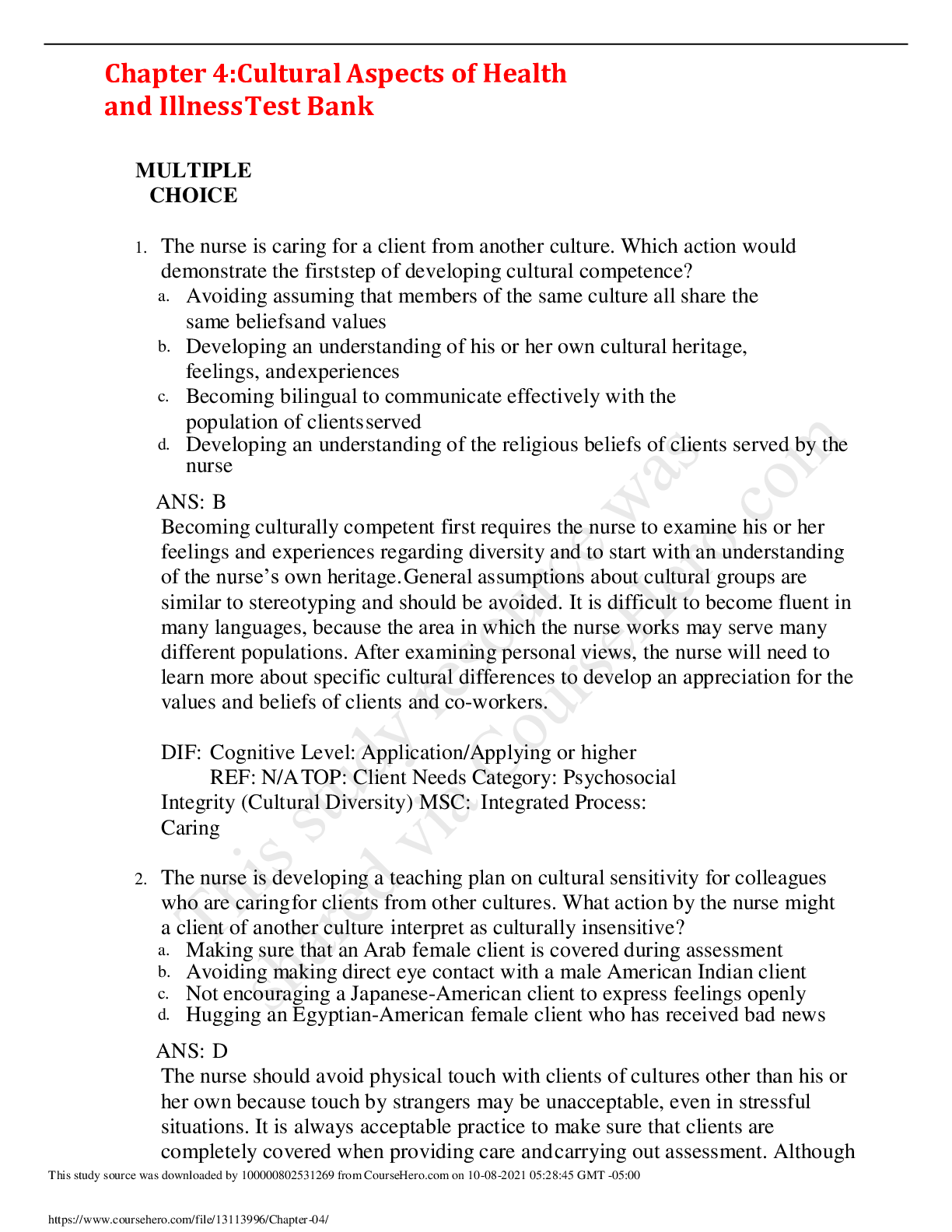
Reviews( 0 )
Document information
Connected school, study & course
About the document
Uploaded On
Sep 26, 2021
Number of pages
21
Written in
Additional information
This document has been written for:
Uploaded
Sep 26, 2021
Downloads
0
Views
31










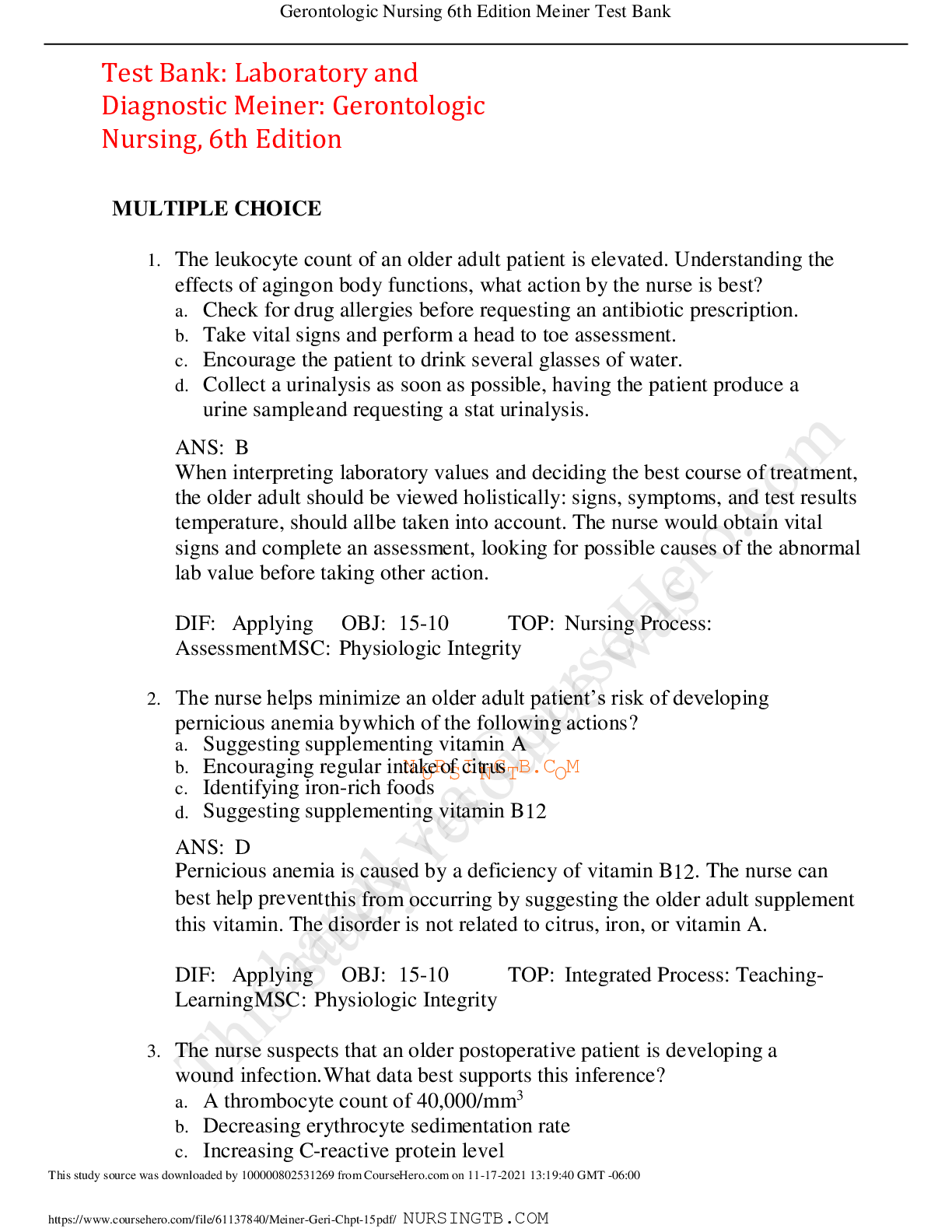


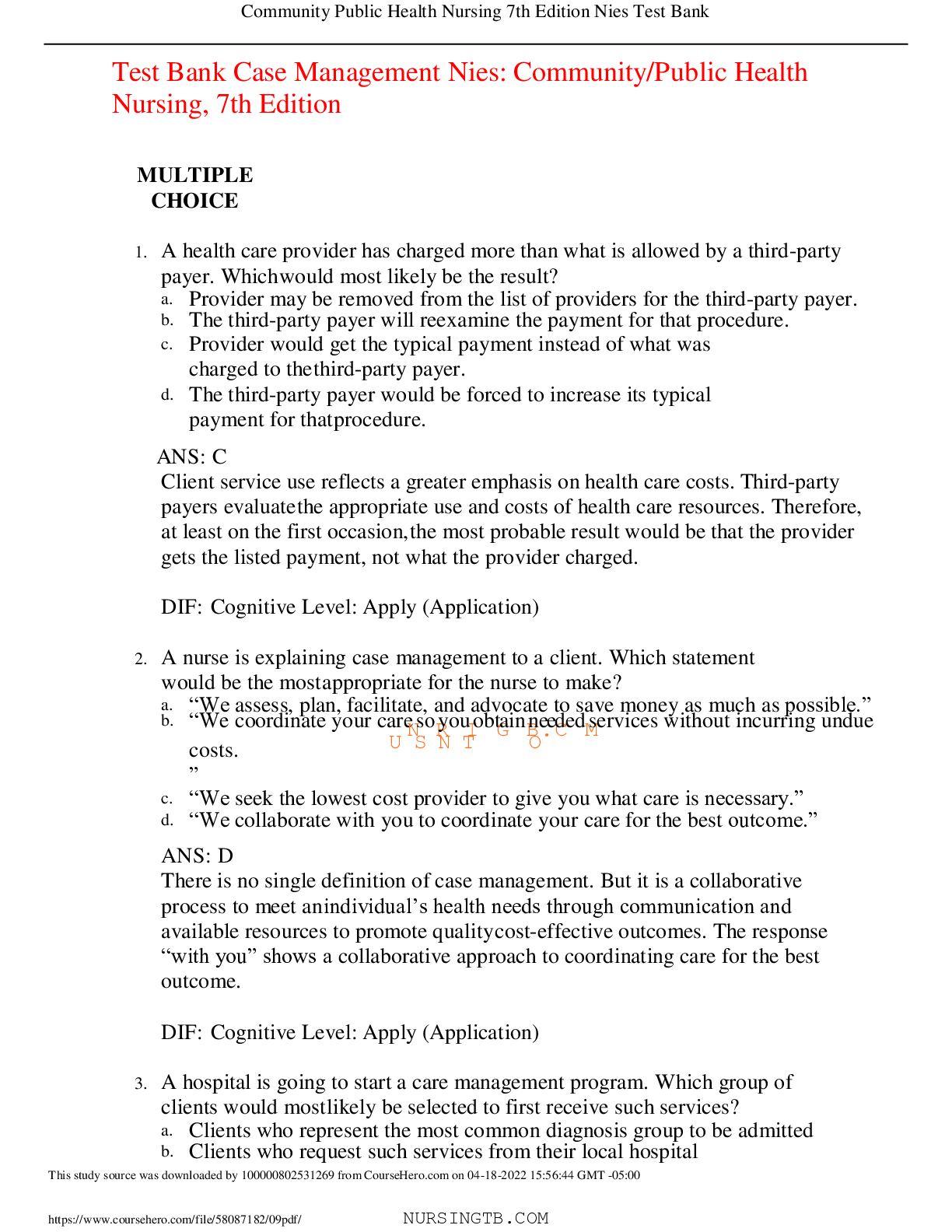


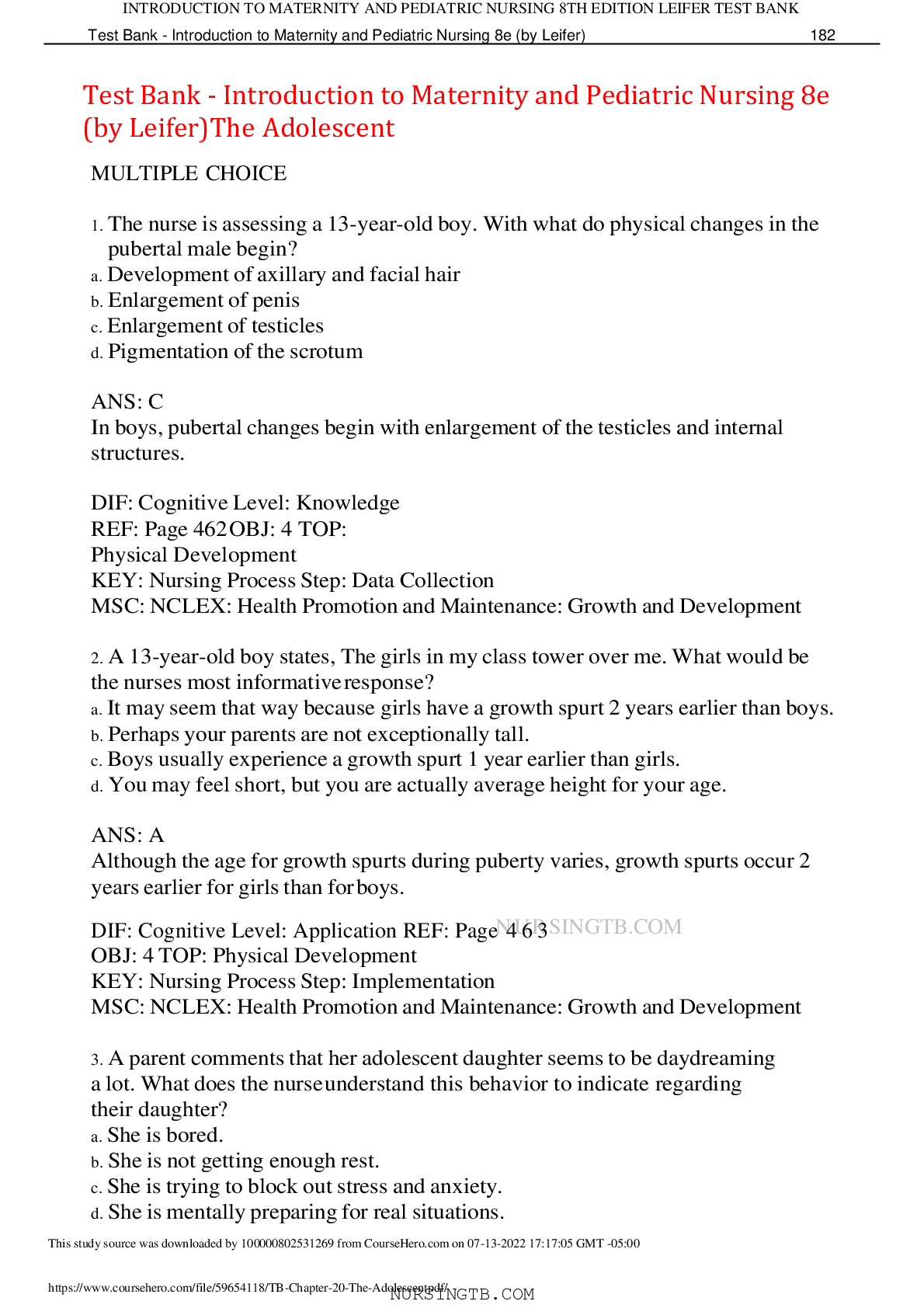
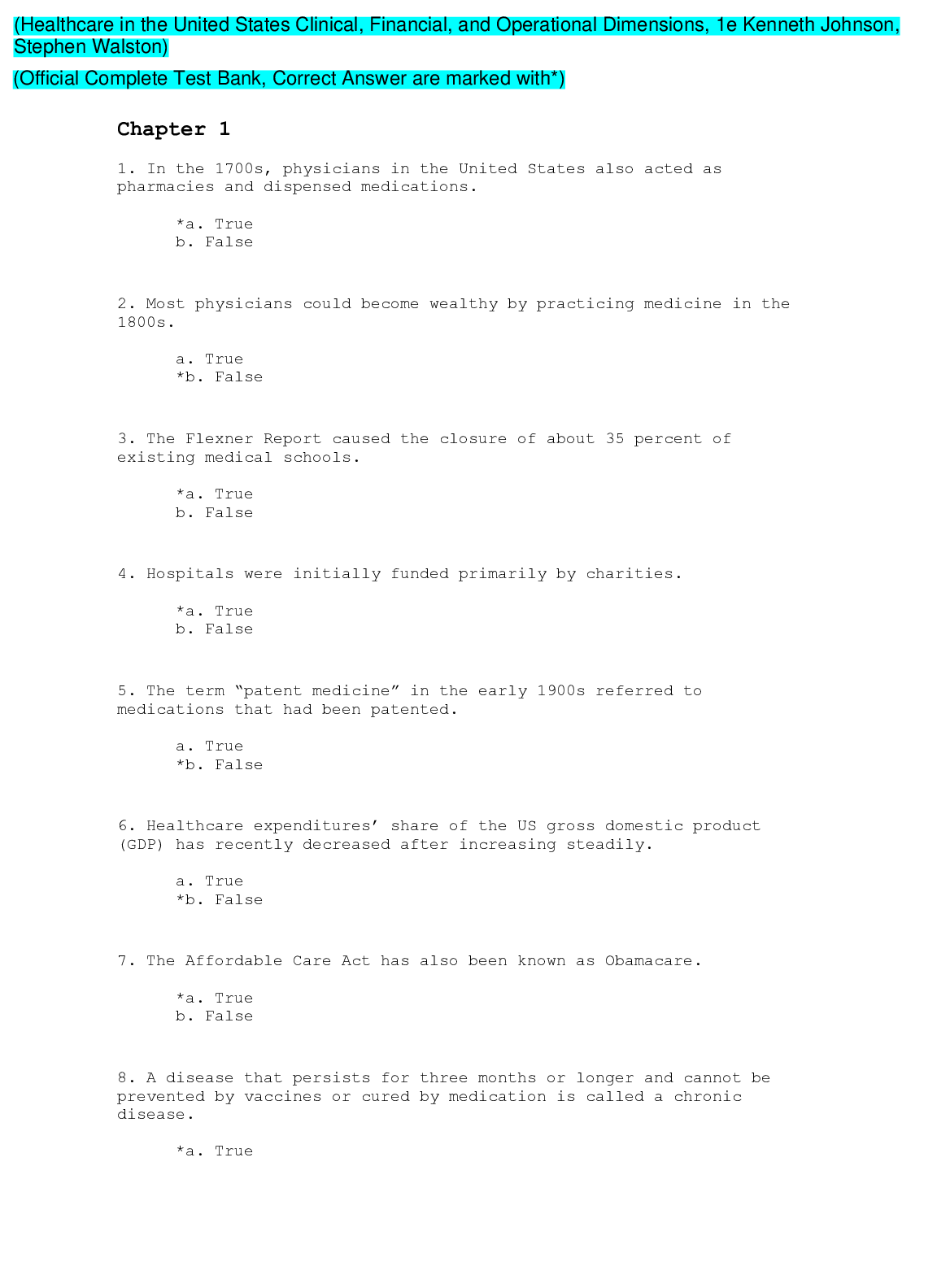
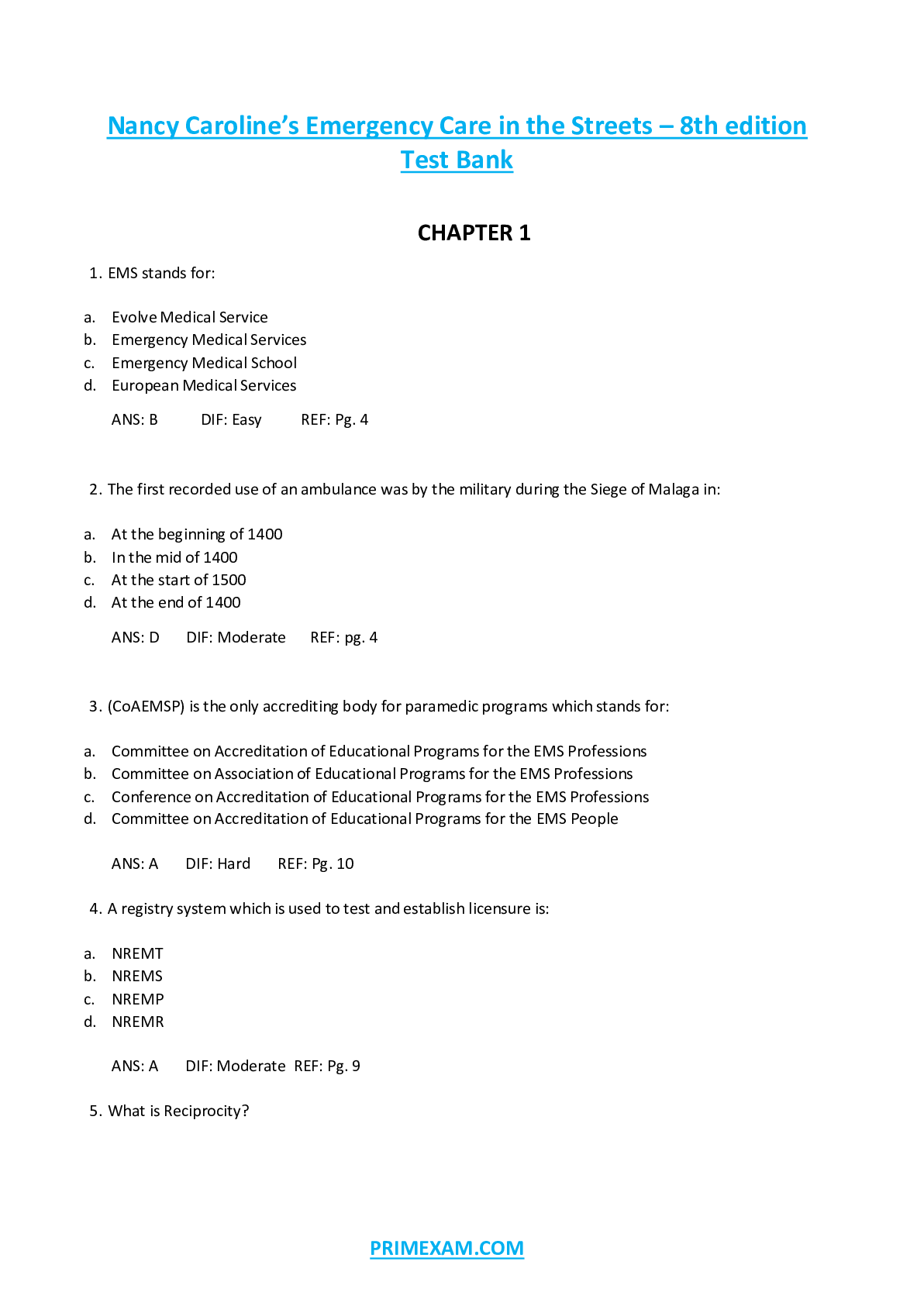
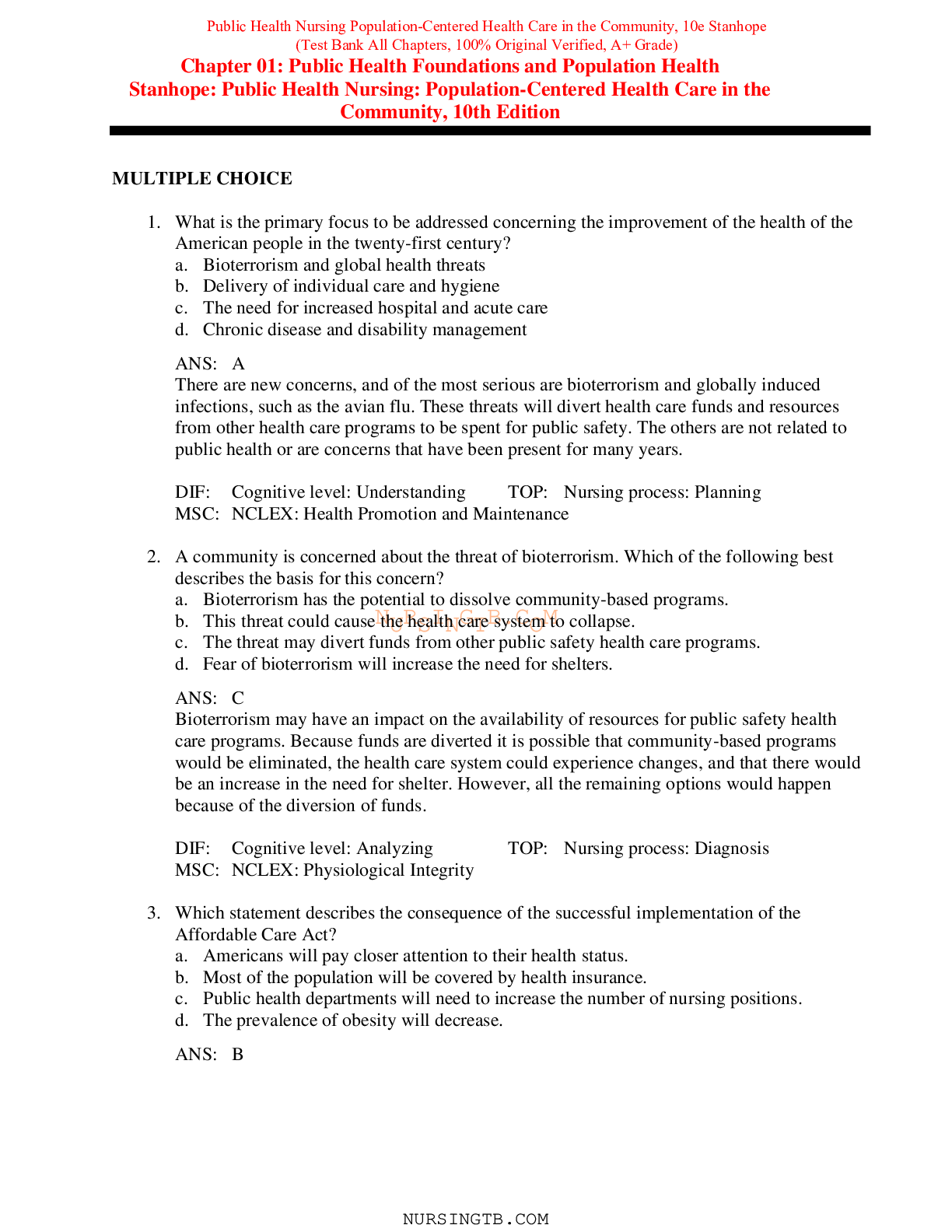

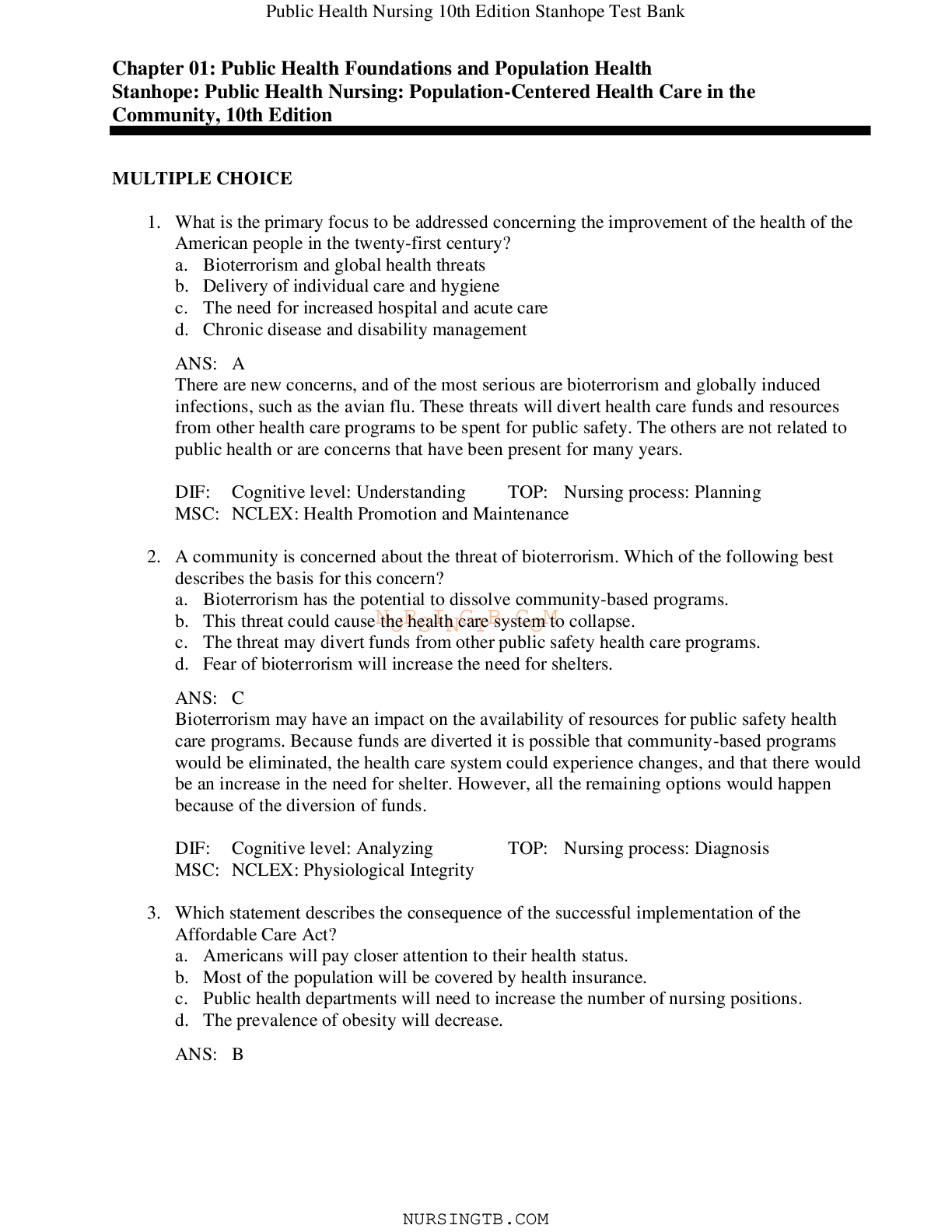
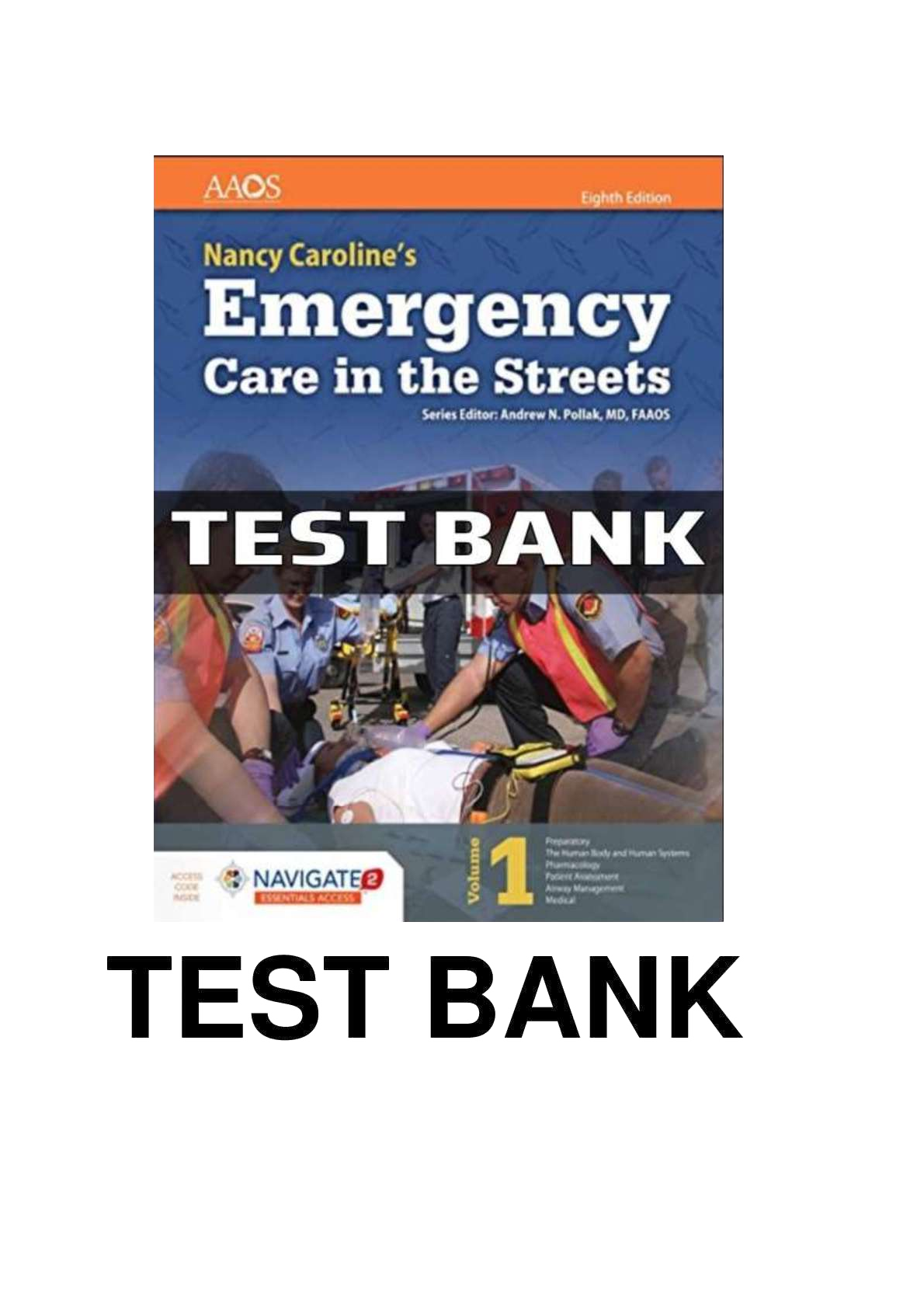
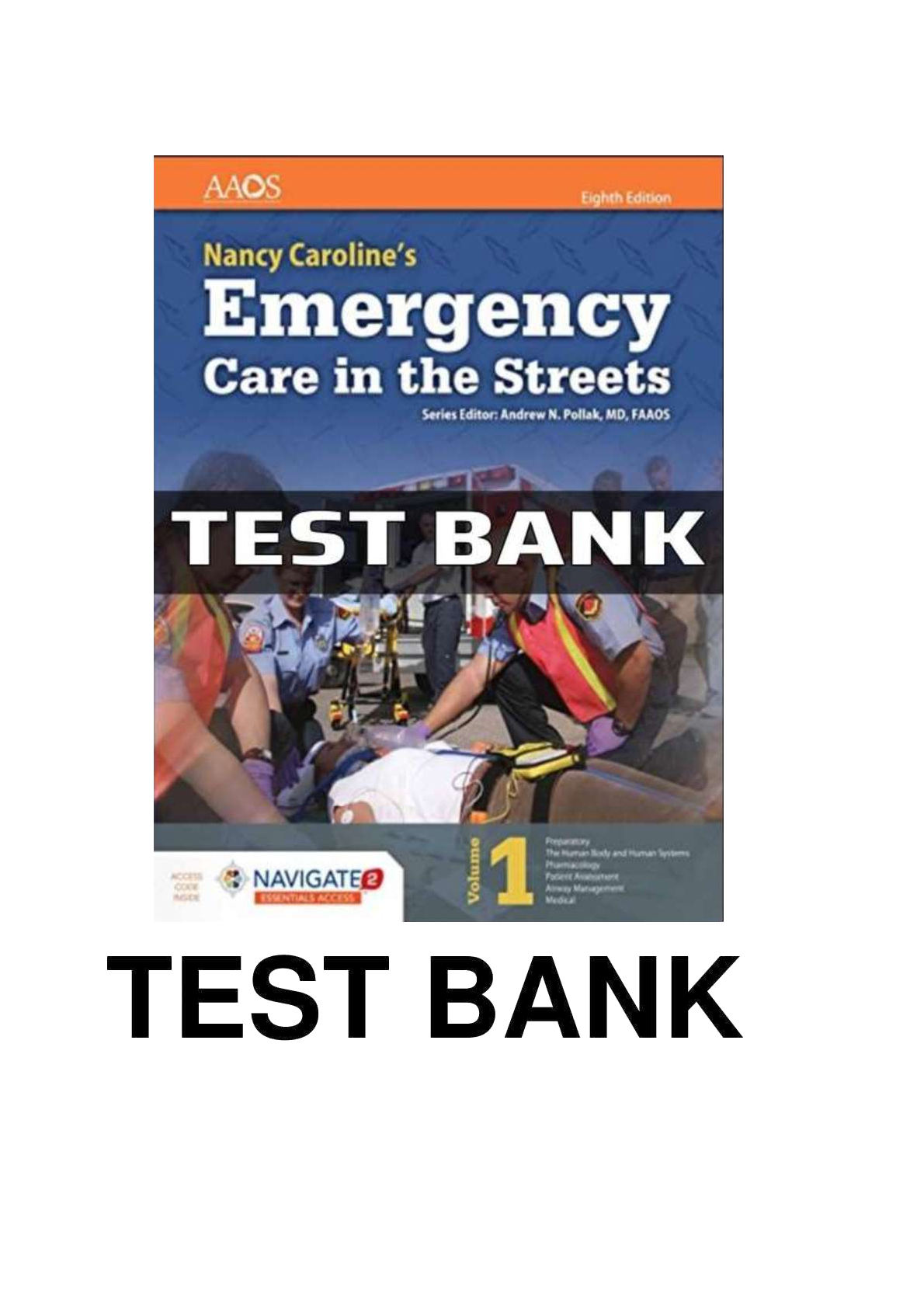
.png)

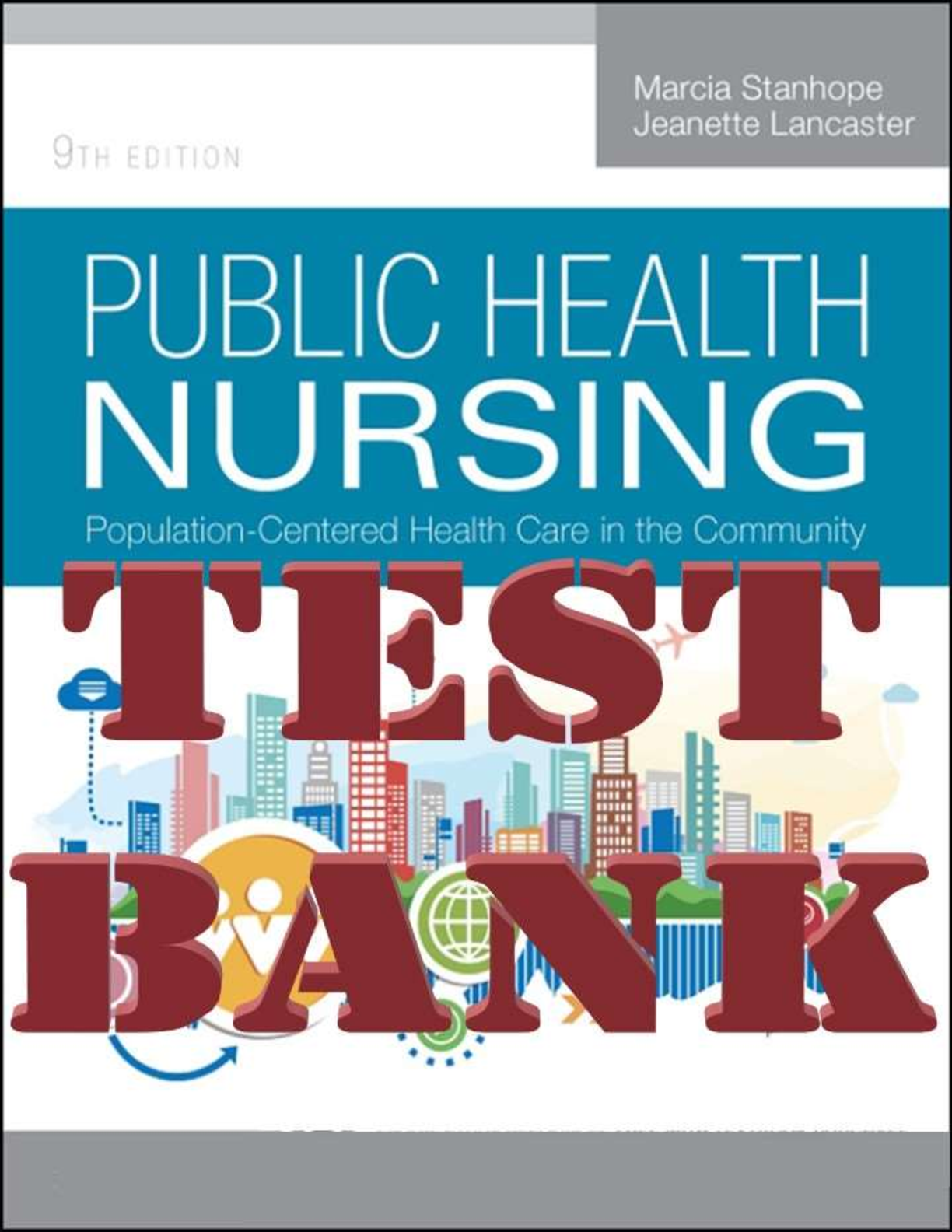

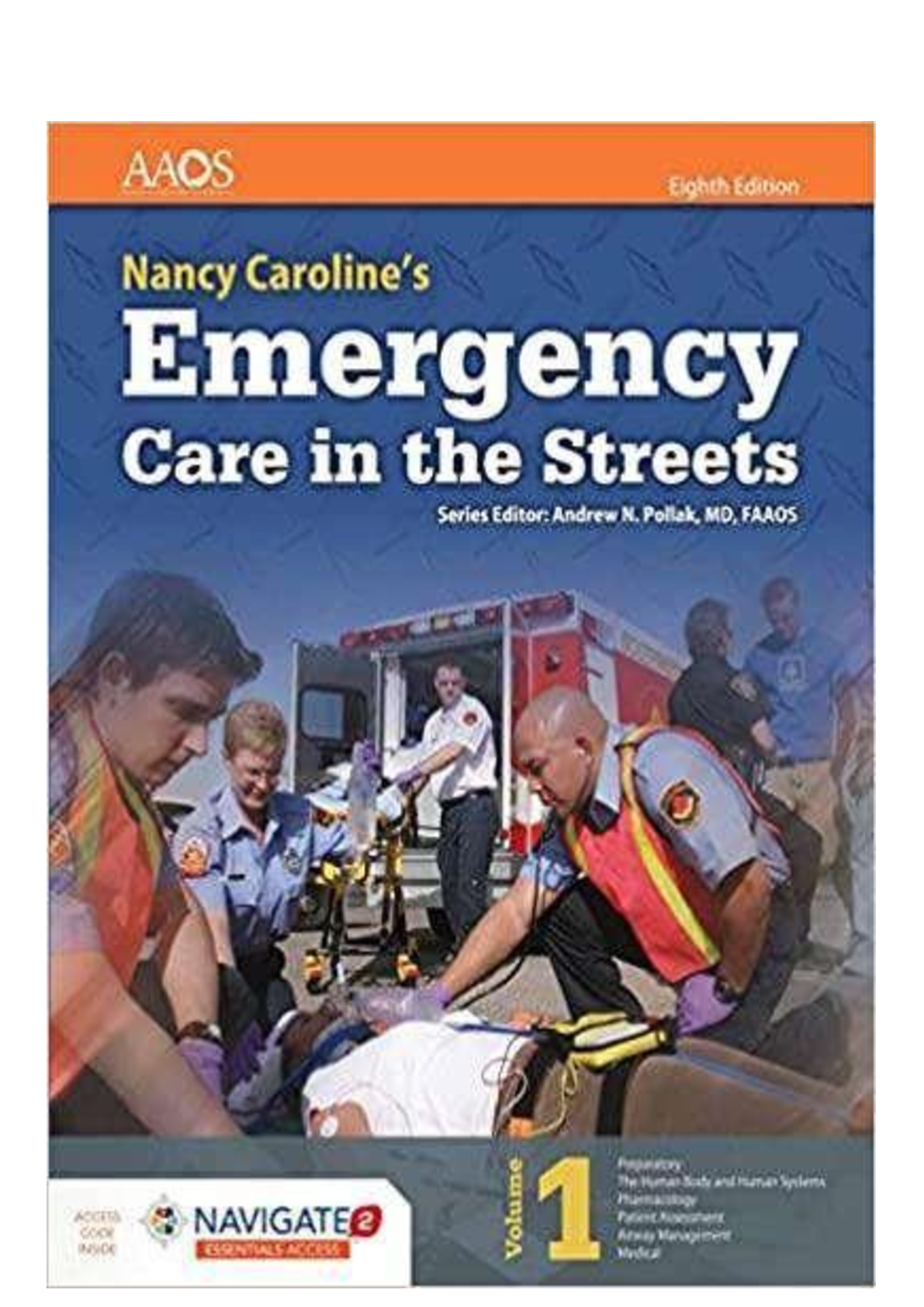

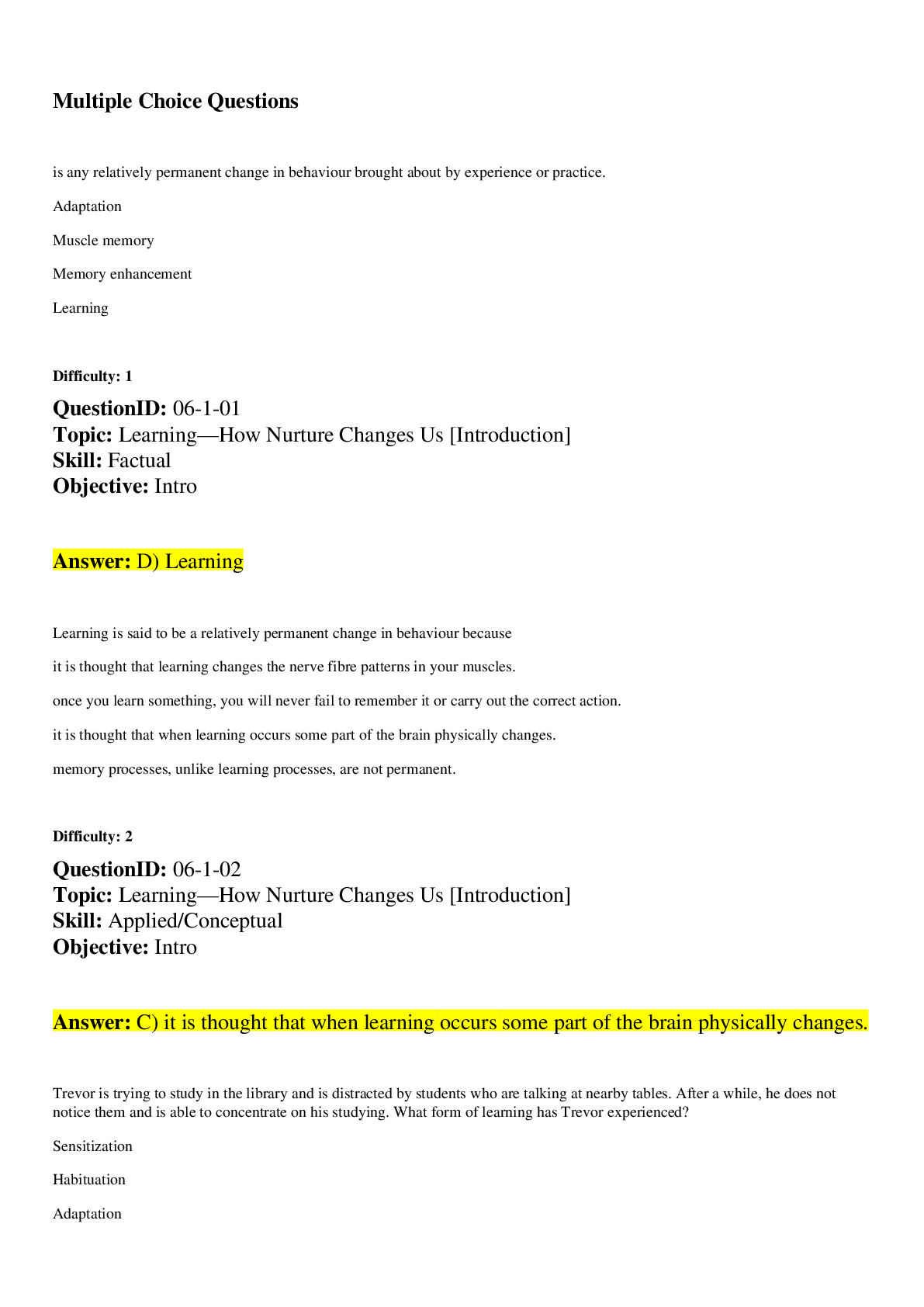
_compressed.png)


